United States Air Force Academy Cadet Chapel
| United States Air Force Academy Cadet Chapel | |
|---|---|
 The Cadet Chapel | |
| General information | |
| Type | Chapel |
| Architectural style | Brutalist |
| Location |
U.S. Air Force Academy, near Colorado Springs, CO |
| Construction started | 1959 |
| Completed | 1962 |
| Height | 150 feet (46 m) |
| Technical details | |
| Floor count | 2 floors |
| Design and construction | |
| Architect |
Walter Netsch, Jr., Skidmore, Owings and Merrill |
| Main contractor | Robert E. McKee, Inc. |
| Awards and prizes |
AIA National Twenty-five Year Award |
|
United States Air Force Academy Cadet Chapel | |
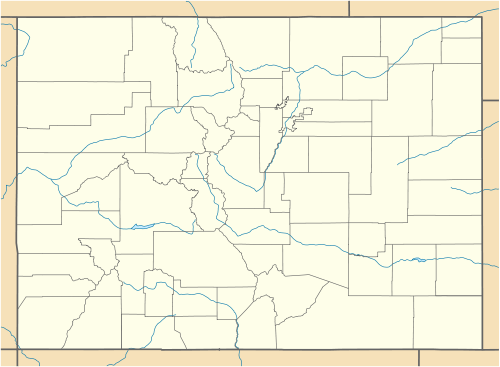  | |
| Location | United States Air Force Academy |
| Built | 1962 |
| Architectural style | Modern Movement |
| Part of | United States Air Force Academy, Cadet Area |
| NRHP Reference # | 04000484[1] |
| Added to NRHP | April 1, 2004 |
The United States Air Force Academy Cadet Chapel, completed in 1962, is the distinguishing feature of the Cadet Area at the United States Air Force Academy north of Colorado Springs. It was designed by Walter Netsch[2] of Skidmore, Owings and Merrill of Chicago. Construction was accomplished by Robert E. McKee, Inc., of Santa Fe, New Mexico. Originally controversial in its design, the Cadet Chapel has become a classic and highly regarded example of modernist architecture. The Cadet Chapel was awarded the American Institute of Architects' National Twenty-five Year Award in 1996[3] and, as part of the Cadet Area, was named a U.S. National Historic Landmark in 2004.
Architecture and construction

The most striking aspect of the Chapel is its row of seventeen spires. The original design called for nineteen spires, but this number was reduced due to budget issues.[4] The structure is a tubular steel frame of 100 identical tetrahedrons, each 75 feet (23 m) long, weighing five tons, and enclosed with aluminum panels. The panels were fabricated in Missouri and shipped by rail to the site. The tetrahedrons are spaced a foot apart, creating gaps in the framework that are filled with 1-inch-thick (25 mm) colored glass. The tetrahedrons comprising the spires are filled by triangular aluminum panels, while the tetrahedrons between the spires are filled with a mosaic of colored glass in aluminum frame.
The Cadet Chapel itself is 150 feet (46 m) high, 280 feet (85 m) long, and 84 feet (26 m) wide. The front façade, on the south, has a wide granite stairway with steel railings capped by aluminum handrails leading up one story to a landing. At the landing is a band of gold anodized aluminum doors, and gold anodized aluminum sheets apparently covering original windows.
The shell of the chapel and surrounding grounds cost $3.5 million to build. Various furnishings, pipe organs, liturgical fittings and adornments of the chapel were presented as gifts from various individuals and organizations. In 1959, a designated Easter offering was also taken at Air Force bases around the world to help complete the interior.
Worship areas
The Cadet Chapel was designed specifically to house three distinct worship areas under a single roof. Inspired by chapels at Sainte-Chapelle in France and the Basilica of San Francesco d'Assisi in Italy, architect Walter Netsch stacked the spaces on two main levels.[5] The Protestant nave is located on the upper level, while the Catholic and Jewish chapels and a Buddhist room are located beneath it. Beneath this level is a larger room used for Islamic services and two meeting rooms. Each chapel has its own entrance, and services may be held simultaneously without interfering with one another.
Protestant chapel
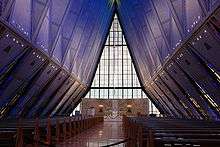
The Protestant Chapel is located on the main floor, and is designed to seat 1,200 individuals. The nave measures 64 by 168 feet (51 m), reaching up to 94 feet (29 m) at the highest peak. The center aisle terminates at the chancel.
The building's tetrahedrons form the walls and the pinnacled ceiling of the Protestant Chapel. Stained glass windows provide ribbons of color between the tetrahedrons, and progress from darker to lighter as they reach the altar. The chancel is set off by a crescent-shaped, varicolored reredos with semi-precious stones from Colorado and pietra santa marble from Italy covering its 1,260-square-foot (117 m2) area. The focal point of the chancel is a 46-foot (14 m) high aluminum cross suspended above it. The pews are made of American walnut and African mahogany, the ends being sculpted to resemble World War I airplane propellers. The backs of the pews are capped by a strip of aluminum similar to the trailing edge of a fighter aircraft wing.
Above the narthex, in the rear, is a choir balcony and organ, designed by Walter Holtkamp of the Holtkamp Organ Company, and built by M. P. Moller of Hagerstown, Maryland. The organ has 83 ranks and 67 stops controlling 4,334 pipes. Harold E. Wagoner designed the liturgical furnishings for both the Protestant and Catholic chapels.
Catholic Chapel
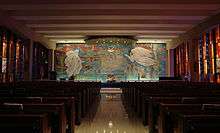
The Catholic Chapel is located below the Protestant Chapel, and seats approximately 500 people. The nave is 56 feet (17 m) wide, 113 feet (34 m) long and 19 feet (5.8 m) high. The focal point of the Catholic Chapel is the reredos, an abstract glass mosaic mural designed by Lumen Martin Winter and composed of varying shades of blue, turquoise, rose and gray tessera to form a portrayal of the firmament. Superimposed on the mural and depicting the Annunciation are two 10-foot (3.0 m) tall marble figures, the Virgin Mary on the left, and the Archangel Gabriel on the right. Above and between these two figures is a marble dove.
In front of the reredos is the altar, a gift from Cardinal Francis Spellman, who dedicated the Catholic Chapel on September 22, 1963. The altar is Italian white marble mounted on a marble cone-shaped pedestal above which is a six-foot sculptured nickel-silver crucifix. Along the side walls of the chapel are the 14 Stations of the Cross, also designed by Lumen Martin Winter, and carved from four-inch (102 mm) thick slabs of marble. The figures are done in Carrara marble, from the same quarries where Michelangelo drew his stone. The classical pipe organ, in the 100-seat choir loft, was designed by Walter Holtkamp and built by M. P. Moller Co. It features 36 ranks and 29 stops controlling its 1,950 pipes.
Jewish chapel
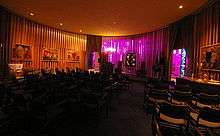
The Jewish Chapel is also on the lower level. Seating 100, it is circular in shape, with a diameter of 42 feet (13 m) and a height of 19 feet (5.8 m). It is enclosed by a vertical grill with inserts of clear glass opening to the foyer. The circular form and transparent walls were used to suggest a tent-like structure. The floor is paved with Jerusalem brownstone, donated by the Israeli Defense Forces.
The walls of the foyer are purple stained glass panels alternating with green and blue stained accent windows. The circular walls of the synagogue are panels of translucent glass separated by stanchions of Israeli cypress. The paintings, done by Shlomo Katz in 1985 and 1986, depict a Biblical story. They are divided into three groups; brotherhood, flight (in honor of the Air Force) and justice.
The focal point of the Jewish Chapel is the Aron Kodesh, which shelters the Scrolls of the Torah, to the right of which hangs the Ner Tamid. In the foyer of the chapel is a display cabinet with a Torah Scroll that was saved from the Nazis during World War II. It was found in Poland in 1989 in an abandoned warehouse and donated to the Jewish Chapel in April 1990. This "Holocaust Torah" is dedicated to the memory of all of those who fought against the Nazis.
Buddhist Chapel

The Buddhist Chapel (Vast Refuge Dharma Hall) is 300 square feet and was designed and built by Ed Shure. Donated in 2007, the Dharma Hall was built freestanding within the existing structure. It is made of Port Orford cedar, and its simply proportioned design welcomes Buddhists of all denominations as well as guests.
The altar and alcove are constructed of American cherry and ash and were designed and built by Takayuki Kida, a traditionally trained Japanese woodworker. The Buddha figure on the altar is Burmese, and the large lion-topped censer is from China. The figure of Avalokiteśvara, known as the one who hears the sounds of the world's suffering, stands near the entry. The arrangement of the altar focuses on the Buddha figure, representing not only gratitude to the historical Shakyamuni Buddha, but also the possibility of awakening, or enlightenment. The altar also offers appreciation for the four elements of life: earth, air, fire, and water.
Ed Shure, the designer and builder of the hall, commented that he is very happy to have played a part in providing a place where people can enjoy the present moment.
Falcon Circle
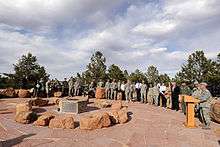
The worship area known as the Cadet Chapel - Falcon Circle came about through a request from the Air Force Academy's followers of Earth-Centered Spirituality, an umbrella of traditions that includes Wicca, Paganism and Druidism. The large stones comprising the circle were removed from the side of the hill overlooking the Academy's visitor center, where erosion threatened to collapse them onto the visitor center. The circular nature in which the stones were placed lent itself to facilitating outdoor worship services.
Following the Earth-Centered community's request, the Academy spent approximately $50,000 to upgrade the area, adding flagstones to enhance the circle's safety and a fire pit to accommodate religious services. Cameras were added to protect the site from unauthorized access.[6]
The Falcon Circle was dedicated in an official ceremony May 3, 2011, making it the newest of the Cadet Chapel's worship areas. It is open to use by all religious communities to worship in a manner respectful of other faiths; however, in the event of scheduling conflicts, the Earth-Centered community receives precedence.
All-faiths rooms
The All-Faiths Rooms are worship areas for smaller religious groups. They are purposely devoid of religious symbolism so that they may be used by a variety of faiths. Distinguishing faith-specific accoutrements are available for each group to use during their worship services.
See also
- United States Air Force Academy, Cadet Area (description and photo of chapel)
- United States Air Force Chaplain Corps
- United States Military Academy Chapel (Protestant)
- Chapel of the Most Holy Trinity (West Point) (Catholic)
- United States Naval Academy Chapel
- Commodore Uriah P. Levy Center and Jewish Chapel (U.S. Naval Academy)
- United States Merchant Marine Academy#Mariners' Memorial Chapel
References
- ↑ National Park Service (2010-07-09). "National Register Information System". National Register of Historic Places. National Park Service.
- ↑ "Walter Netsch Interviewed by Detlef Mertins". SOM.com. Retrieved 2010-01-05.
- ↑ "United States Air Force Academy - Cadet Chapel". SOM.com. Retrieved 2010-01-05.
- ↑ "Art: Spires That Soar". Time.com. 1962-07-27. Retrieved 2010-01-05.
- ↑ "National Historic Landmark Nomination" (PDF). National Park Service. Retrieved 2010-01-05.
- ↑ "Cadet Chapel".
External links
| Wikimedia Commons has media related to United States Air Force Academy Cadet Chapel. |
- Great Buildings Online entry
- Skidmore, Owings and Merrill page
- USAFA Cadet Area National Historic Landmark nomination package
- Virtual Tour - On Roundus
Coordinates: 39°00′30″N 104°53′25″W / 39.00830°N 104.89025°W
